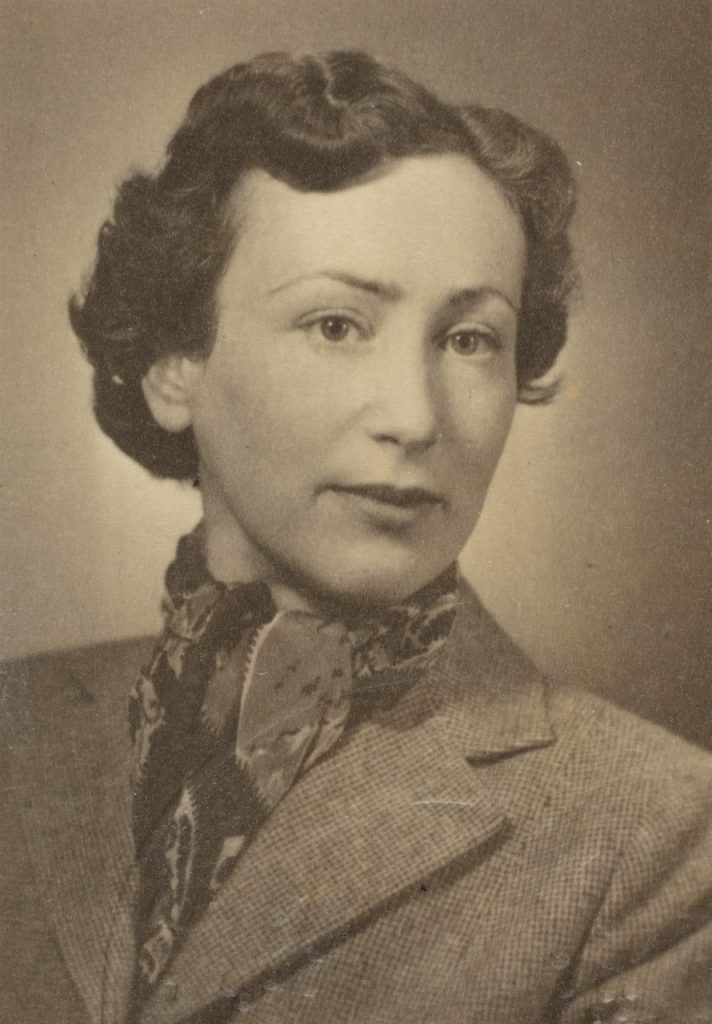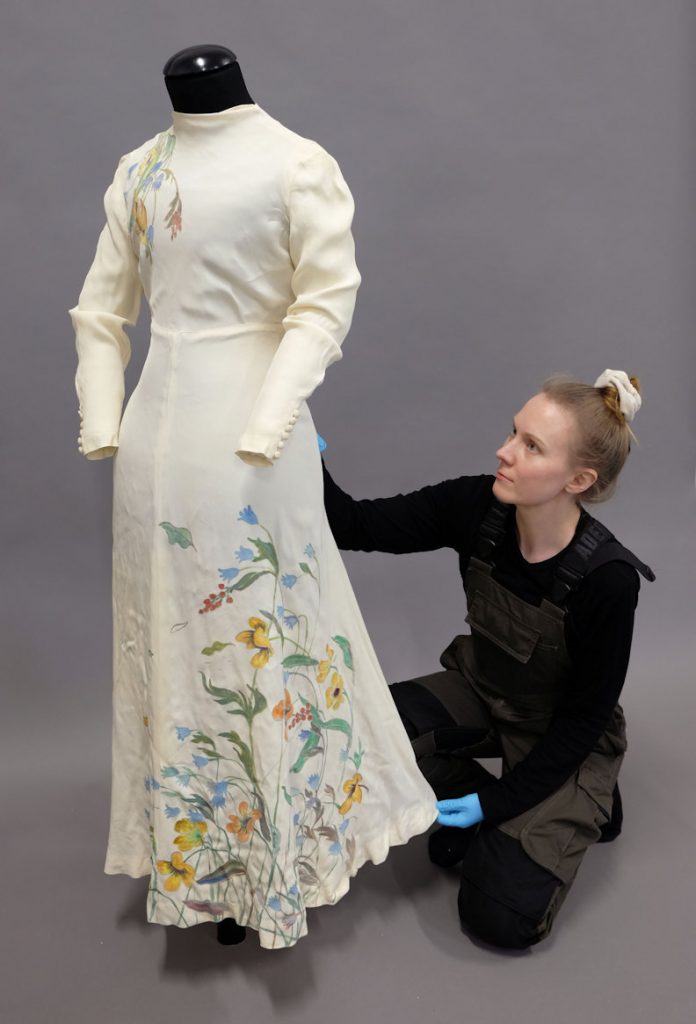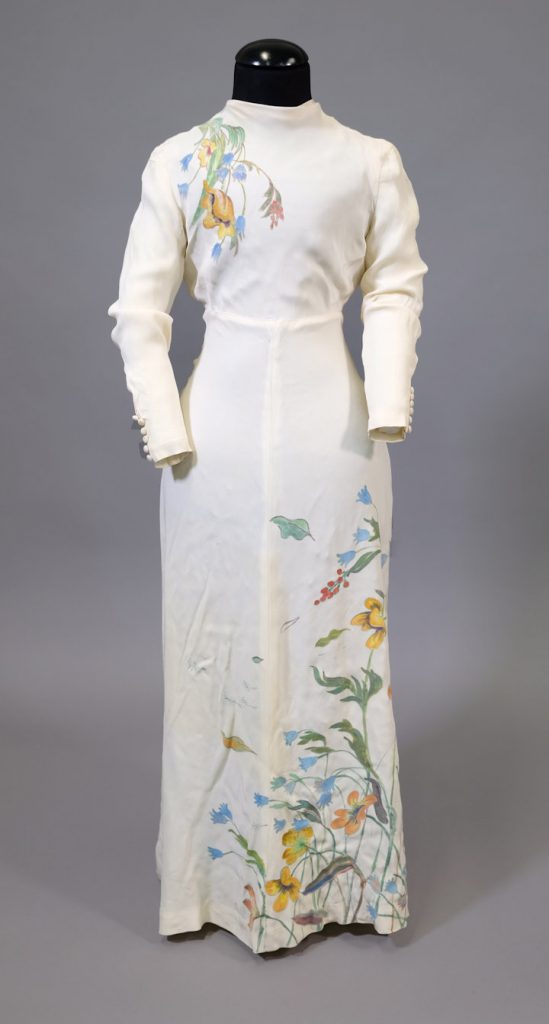The Helsinki University Museum’s craft science collection includes dozens of evening dresses, almost all of which are unique, bespoke gowns. However, one evening dress in the collection is a particular rarity: this silk dress has also served as a canvas for the noted Finnish artist Sam Vanni.
A translator in artistic circles
The dress was owned by Maya Vanni, originally Maja London (1916–2010). She was born in Turku and, after completing her matriculation examination, moved to Paris in 1935. She fit right in with the locals, studying, partying, conversing and becoming friends with artists. Her circle of friends included theatre director Vivica Bandler and artist and writer Tove Jansson.

Having changed her name to the more French-sounding Maya, she returned reluctantly to Finland after the outbreak of World War II. In 1941 she married the artist Samuel Besprosvanni and the couple changed their surname to Vanni. The marriage ended in the early 1950s, and their divorce was finalised in 1958.

Maya Vanni was an alumna of the University of Helsinki, the holder of two master’s degrees and a fine example of lifelong learning. As an adult, she first studied Romance philology at the University of Helsinki, completing her master’s thesis in 1955. After retiring, she returned to the University of Helsinki to study philosophy, completing another master’s thesis in 1986. Maya Vanni worked as a translator for, among others, the Finnish Post and Telegraph Office and the Prime Minister’s Office, and also translated films and books.
Tove Jansson described Maya Vanni as a “sweet and sensible person when you get to know her better”, which suggests that Vanni was an individual with multiple layers that opened up upon closer acquaintance. As of 1957, the friendship between Vanni and Jansson deepened, they corresponded with each other and, among other things, Vanni read and commented on Jansson’s texts before their publication. Jansson’s Moomin characters have features of people close to her although few of the characters represent only one person. Little My has features of several people, including Tove Jansson herself, but also Maya Vanni. This was made tangible to us at the Helsinki University Museum when we took photos of the dress for this article. Vanni’s dress did not fit any available mannequin. Conservator Anni Tuominen had to completely remodel a mannequin for the dress because that was how petite Maya Vanni was.

The evening dress as a canvas
The dress is from circa 1950, and a label on the inside indicates that it was made in a Helsinki-based fashion boutique called Domina. The white evening dress is made of luxuriously thick silk satin, of which the reverse, matte side of the fabric has been used instead of the glossy right side. The patterns have been painted on the fabric after cutting the pieces of the dress, but before sewing. This can be seen from the fact that the patterns at the seams are not fully aligned, and the patterns continue into the seam allowances.

According to information that accompanied the dress when it was donated to the Helsinki University Museum, the flowers were painted by Maya Vanni’s then-husband Sam Vanni, using fabric paint purchased from the Beckers paint shop. Academician and painter Sam Vanni is known in Finland particularly as a pioneer of abstract art, which is why the idea of him painting flowers on an evening dress may sound odd. However, his career was highly diverse, and he also decorated other objects by painting them. For example, a ceramic pot he painted has been immortalised in many of his early works.
Unfortunately, we have no information about where and when Maya Vanni’s dress has been worn. It would be particularly interesting to learn about the design and manufacturing of the dress. Who came up with the idea of using an evening dress as a canvas? The Beckers paint shop in Stockholm was a producer of quality colours for artists that expanded its target group at the turn of the 1940s and 1950s to include consumers because the demand for do-it-yourself supplies had increased with the establishment of the folkhem (people’s home) concept. Did Sam Vanni buy the fabric paints on impulse when purchasing paints from Beckers in Stockholm? Or were they on the shopping list together with oil paints?

How did the dress end up in the craft science collection?
The craft science collection consists of objects that were in the possession of institutes and teachers providing craft teacher education in Helsinki from the 1880s to 2002. Craft teacher education commenced in Helsinki in 1885 and was merged with the University of Helsinki in 1975. The collection was born when teachers began to make and acquire models and visual aids to support teaching. The collection was brought under the auspices of the Helsinki University Museum in 2003.

The dress was donated by the textile handicraft teacher Ruth Henriksson (1919–1999). She was an arts and crafts enthusiast who travelled extensively and wrote about the textile cultures of different countries for various publications. Henriksson graduated as a craft teacher in 1942 from the last Swedish-language class of the Helsinki Crafts School. She was also an active member of the Association of Craft Teachers, a professional organisation that had close links to education in the field, which meant that Henriksson remained in contact with her alma mater throughout her career.
Maya Vanni emigrated permanently to Israel in 1992. While preparing for the move, she returned to Tove Jansson the letters she had received from her, and it was at this stage that the evening dress also changed owners. Vanni and the donor of the dress Ruth Henriksson had been neighbours, and Vanni undoubtedly knew about Henriksson’s interest in textile culture. Soon after gaining possession of the dress, Henriksson donated it to the University of Helsinki’s craft teacher programme, undoubtedly understanding that it was not just any dress, but one that provides a fascinating window into the community of young artists in the early 20th century.
Helena Hämäläinen, curator
Translation: University of Helsinki Language Services
Sources:
Anttila, M. 2017. Sarja käsityönopetuksen kehittäjistä, osa 21 – Ruth Henriksson. In Tekstiiliopettaja 3/2017, p. 18.
Beckers – En färgstark historia. 2020. Https://beckers.se/om-beckers, accessed on 28 January 2022
Henriksson, R. Lindfors, L. 1988. Textilkultur – mitt livslånga intresse: samlade artiklar och reportage. Åbo Akademi. Institutionen för lärarutbildning.
Hämäläinen, H. 2016. Kolme näkökulmaa Helsingin yliopistomuseon käsityötieteen kokoelmaan. Master’s thesis. University of Helsinki, Faculty of Behavioural Sciences, Department of Teacher Education. Electronic version available at https://helda.helsinki.fi/handle/10138/173530?locale-attribute=en
Odrischinsky, E. 2007. Lilla Maya i Jerusalem. In Hufvudstadsbladet, 28 January 2007.
Sam Vanni: Vuodet 1926–1959. Ed. Tuula Karjalainen, Mikko Oranen, Erja Pusa. 1997. Helsingin kaupungin taidemuseon julkaisuja n:o 53. Helsinki, Helsingin taidemuseo.
Westin, B. and Svensson H. 2014. Kirjeitä Tove Janssonilta. Schildts & Söderströms. Helsinki 2014.
